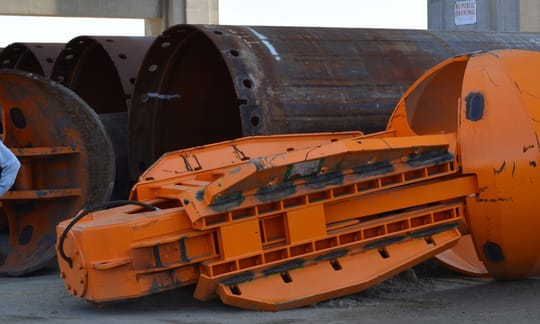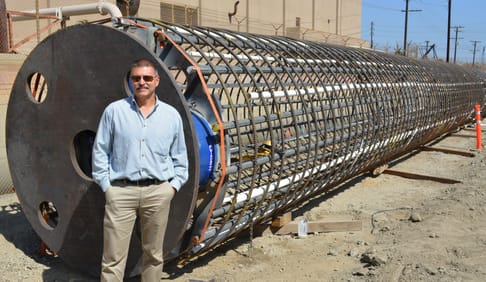
Port of Long Beach Construction Tour

Good friend and Atlas collaborator Steve Dickenson and I had a free day in Los Angeles after the California Strong Motion Instrumentation Program Seminar. When traveling with Steve, you can always count on a Port Tour, and the tour he arranged at the Port of Long Beach exceeded all expectations.
At the time of our visit, the Port had $300 million in active construction contracts spread across 9 general contractors. Doug Thiessen, the Port's Managing Director of Engineering and, for the afternoon, our tourguide, showed us dredging, land reclamation, railyard construction, wharf piling, and bridge foundations. The amount of activity was astonishing and the coordination between projects, without disrupting Port operations, clearly requires a Herculean effort.
Two foundation projects in particular caught my interest.
Middle Harbor Phase 2 Wharf Piles
The $1.2 billion Middle Harbor project is a multifaceted infrastructure improvement that creates advanced wharf face for the largest container ships in the world. More information is here:
http://www.polb.com/about/projects/middleharbor.asp
The photo at left is particularly interesting to me because it reflects the fascinating history of the Port of Long Beach. Many of you are aware that Long Beach is a highly productive oilfield and that historical extraction has caused tens of feet of subsidence. The piles supporting this part of the Middle Harbor wharf deck are misaligned because of obstructions and rubble in the upper soil profile. The rubble fill was placed to correct the oil-related subsidence. I'm sure that the oil value is significant, but so is the cost of redesigning the waffle-slab wharf deck to accommodate the pile misalignment. Heavy and high-value infrastructure on soft ground is complex enough, and adding in man-made complications like subsidence and random fills makes this one of the most complex geotechnical conditions in the world.
Gerald Desmond Bridge Replacement

The bridge that connects the Port to Interstate 710 on the west is being replaced with a $1 billion, 250-foot high cable stayed bridge. The stay tower will be 500 feet high and founded on 8-foot diameter shafts up to 220 feet deep. During our tour Mr. Thiessen showed us all 3 casing advancers active on the project. Very powerful equipment vibrates and rotates a heavy casing like a giant biscuit cutter as the clamshell digs the soil out from the middle. The scale of this equipment is really impressive up close. Casing advancers are expensive to mobilize and only work on the largest projects. Having three of them on one jobsite is pretty exceptional.
Load testing is an integral part of high-capacity pile projects, moreso on critical infrastructure in deep sediments. The four Osterbeerg cells in this reinforcing cage are 24" diameter. Cast into the test pile along with strain gauges and other instruments, the load test applies hydraulic pressure is applied from the surface to force the pile tip downward using the shaft above for a reaction. The design of the test pile itself is a fascinating subject, and seeing so many test piles with such high test loads was a highlight of the day.

Here's a smaller test pile at the GDB project after the reinforcing steel, O-cells, and strain gauges are cast into the shaft. Each instrument will tell some part of a complicated and important story about how these piles transfer bridge loads into the foundation soils.
Overall it was a marvelous afternoon spent with good friends looking at some of the largest construction projects on the west coast. I'd like to thank Doug Thiessen and the Port for showing us around and getting us behind the scenes, and Steve Dickenson for arranging such an excellent guided tour.

Doug founded Atlas Geotechnical in 2004, and focuses on working for Contractors and Operators, tackling the most challenging problems.